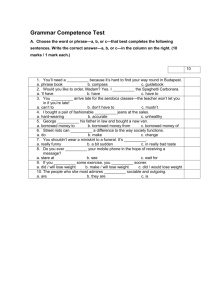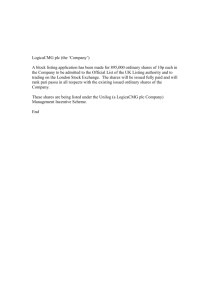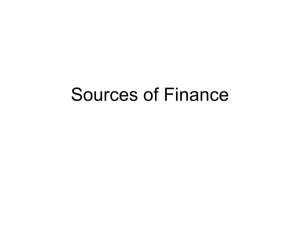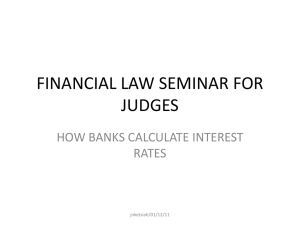interest deductibility
advertisement
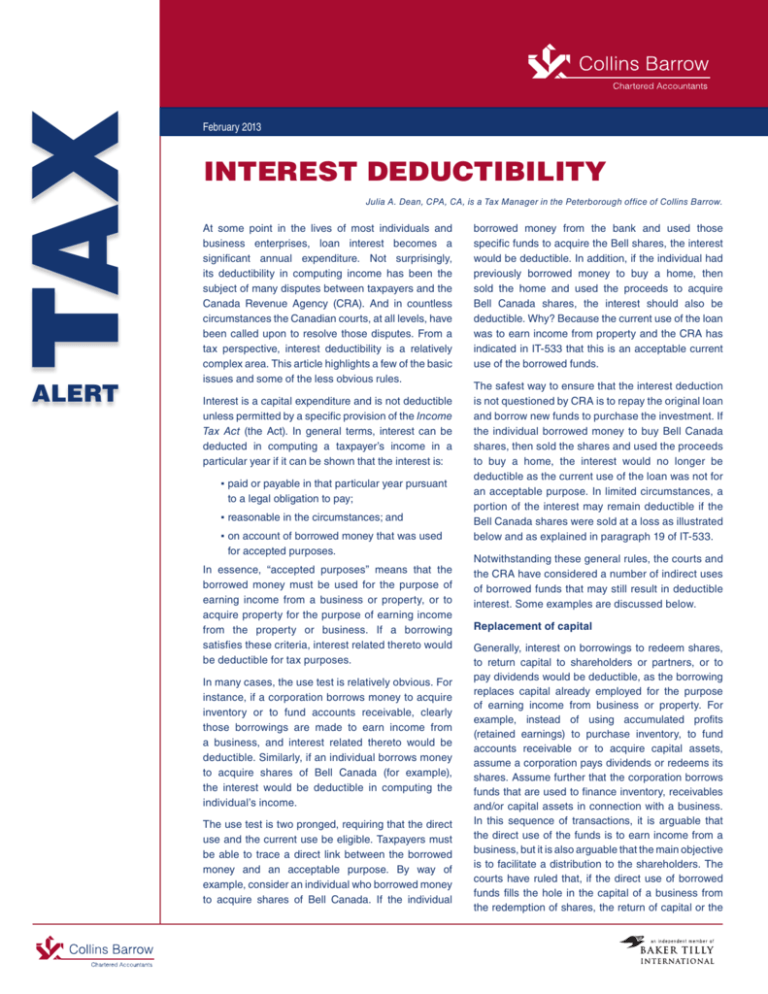
TAX ALERT February 2013 INTEREST DEDUCTIBILITY Julia A. Dean, CPA, CA, is a Tax Manager in the Peterborough office of Collins Barrow. At some point in the lives of most individuals and business enterprises, loan interest becomes a significant annual expenditure. Not surprisingly, its deductibility in computing income has been the subject of many disputes between taxpayers and the Canada Revenue Agency (CRA). And in countless circumstances the Canadian courts, at all levels, have been called upon to resolve those disputes. From a tax perspective, interest deductibility is a relatively complex area. This article highlights a few of the basic issues and some of the less obvious rules. Interest is a capital expenditure and is not deductible unless permitted by a specific provision of the Income Tax Act (the Act). In general terms, interest can be deducted in computing a taxpayer’s income in a particular year if it can be shown that the interest is: ▪▪ paid or payable in that particular year pursuant to a legal obligation to pay; ▪▪ reasonable in the circumstances; and ▪▪ on account of borrowed money that was used for accepted purposes. In essence, “accepted purposes” means that the borrowed money must be used for the purpose of earning income from a business or property, or to acquire property for the purpose of earning income from the property or business. If a borrowing satisfies these criteria, interest related thereto would be deductible for tax purposes. In many cases, the use test is relatively obvious. For instance, if a corporation borrows money to acquire inventory or to fund accounts receivable, clearly those borrowings are made to earn income from a business, and interest related thereto would be deductible. Similarly, if an individual borrows money to acquire shares of Bell Canada (for example), the interest would be deductible in computing the individual’s income. The use test is two pronged, requiring that the direct use and the current use be eligible. Taxpayers must be able to trace a direct link between the borrowed money and an acceptable purpose. By way of example, consider an individual who borrowed money to acquire shares of Bell Canada. If the individual borrowed money from the bank and used those specific funds to acquire the Bell shares, the interest would be deductible. In addition, if the individual had previously borrowed money to buy a home, then sold the home and used the proceeds to acquire Bell Canada shares, the interest should also be deductible. Why? Because the current use of the loan was to earn income from property and the CRA has indicated in IT-533 that this is an acceptable current use of the borrowed funds. The safest way to ensure that the interest deduction is not questioned by CRA is to repay the original loan and borrow new funds to purchase the investment. If the individual borrowed money to buy Bell Canada shares, then sold the shares and used the proceeds to buy a home, the interest would no longer be deductible as the current use of the loan was not for an acceptable purpose. In limited circumstances, a portion of the interest may remain deductible if the Bell Canada shares were sold at a loss as illustrated below and as explained in paragraph 19 of IT-533. Notwithstanding these general rules, the courts and the CRA have considered a number of indirect uses of borrowed funds that may still result in deductible interest. Some examples are discussed below. Replacement of capital Generally, interest on borrowings to redeem shares, to return capital to shareholders or partners, or to pay dividends would be deductible, as the borrowing replaces capital already employed for the purpose of earning income from business or property. For example, instead of using accumulated profits (retained earnings) to purchase inventory, to fund accounts receivable or to acquire capital assets, assume a corporation pays dividends or redeems its shares. Assume further that the corporation borrows funds that are used to finance inventory, receivables and/or capital assets in connection with a business. In this sequence of transactions, it is arguable that the direct use of the funds is to earn income from a business, but it is also arguable that the main objective is to facilitate a distribution to the shareholders. The courts have ruled that, if the direct use of borrowed funds fills the hole in the capital of a business from the redemption of shares, the return of capital or the 2 payment of dividends, such indirect use of the funds is an eligible use for purposes of interest deductibility. A taxpayer may restructure borrowings and the ownership of assets and still meet the direct use test. However, on a cautionary note, the CRA will look to apply the general anti-avoidance provisions of the Act if it considers such a restructuring to be abusive. The Supreme Court of Canada considered a prime example of an allowable restructuring in The Queen v. John R. Singleton (2001 DTC 5533). In that case, Mr. Singleton, a partner in a partnership, received a full repayment of his partnership capital account. Mr. Singleton used those funds to repay the mortgage on his home, which at the time was incurring interest that was not deductible for tax purposes. He then remortgaged his home and used the funds to contribute capital to the partnership. The Supreme Court ruled that this re-contribution of capital was an eligible direct use of borrowed funds and allowed Mr. Singleton to deduct mortgage interest on his personal tax return. Loan from a corporate parent to a subsidiary In some circumstances, a parent corporation borrows funds for the purpose of making non-interest bearing advances to a subsidiary (both corporations resident in Canada). Interest on those borrowings can be deducted by the parent corporation if it can demonstrate that the interest-free loan had the effect of increasing the income-earning capacity of the related company, and therefore the ability to pay dividends to the parent. Borrowing to acquire shares from spouse In some cases, it is possible to rearrange borrowings and asset ownership to facilitate interest deductibility. Consider a situation in which an individual, “Mr. A,” owns 100% of a corporation, “B-Co.” Mr. A wishes to sell 20% of B-Co’s share capital to Mr. A’s spouse, “Mrs. A,” for income splitting purposes. Assume the fair market value of the 20% interest in B-Co is $200,000, and that the shares are qualified small business corporation shares for purposes of the capital gains exemption. Further, assume that Mr. and Mrs. A have a $200,000 mortgage on their home on which they pay non-deductible interest. In order to avoid the income attribution rules (discussed in the spring 2009 issue of Tax Alert), Mrs. A must give Mr. A consideration for the fair market value of the shares. Mr. A could borrow $200,000 and use the proceeds to repay the mortgage. Mrs. A could borrow $200,000, providing the home as security, and use the funds to acquire a 20% interest in the shares of B-Co. In this case, the direct use of the funds by Mrs. A would be for the purchase of an income-producing property, the shares of B-Co, and reasonable interest paid by her would be deductible in computing her income. Mr. A could use the proceeds from the disposition of his shares to repay his loan. Mr. A would realize a capital gain on the sale of his shares, which, subject to his personal tax circumstances, could be sheltered from income tax with his capital gains exemption. The Supreme Court considered a similar fact scenario in Lipson and Lipson v. The Queen (2009 DTC 5015). The taxpayer in that case ultimately lost, but on other grounds than the arrangement to convert nondeductible interest to deductible interest. Investment sold at a loss and a portion of the loan remains outstanding It is not uncommon for taxpayers to find themselves in a loss position with respect to investments, particularly in recent years. Where assets are sold and the proceeds are insufficient to repay borrowings incurred to acquire those assets, interest paid on the shortfall remains deductible even though the borrowed funds have ceased to meet the purpose test. For example, assume a corporation borrows $100,000 to acquire shares of Encana for the purpose of earning dividend income. Five years later, the shares of Encana are sold, at a loss, for $40,000, and at that time the balance of the original loan is $75,000. The corporation would be entitled to deduct interest on the original loan up to a maximum of $35,000. This scenario assumes that the $40,000 proceeds were used to repay a portion of the original loan. If the proceeds of the sale are used for other purposes, the interest on that portion would only be deductible if the use of those proceeds meets the purpose tests set out in the Act. However, if the proceeds are used, for example, to repay a noninterest bearing shareholder advance, the deduction of interest would be limited to the interest on $35,000. 3 Borrowing to honour a guarantee The use of borrowed money to honour a guarantee is not considered a direct income-earning use unless: ▪ ▪the guarantor charged a guarantee fee to the borrower; or ▪ ▪under the terms of the guarantee, the guarantor acquires a claim on the defaulting party for the amount of the guarantee, and interest is charged. In the absence of a guarantee fee, or interest income on the claim on the defaulting party, the guarantor realizes no income from the provision of the guarantee. Therefore, interest on the money borrowed to honour the guarantee would not be deductible unless honouring the guarantee was an eligible, indirect use of the borrowed funds. This might be the case, for example, where a shareholder guarantees corporate loans with the expectation that, with the borrowed funds, the corporation’s ability to pay dividends would be enhanced. Again, this article is intended to highlight some of the key areas of interest deductibility. It is not intended as an exhaustive discussion. Contact your Collins Barrow advisor for more information § Collins Barrow periodically publishes a Tax Alert for its clients and associates. It is designed to highlight and summarize the continually changing tax and business scene across Canada. While Tax Alert suggests general planning ideas, we recommend professional advice always be sought before taking specific planning steps. www.collinsbarrow.com info@collinsbarrow.com Editor: Robert W. Rock, CPA, CA, CFP rrock@collinsbarrow.com 613.768.7547 Clarity Defined.


